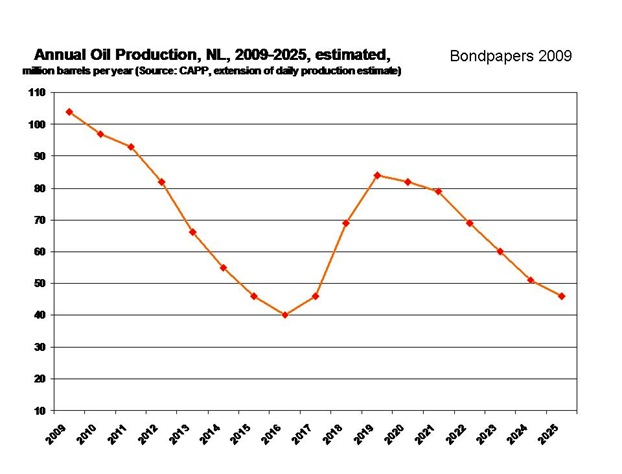In 2007, the contracts manager at Metalcraft Marine, a Kingston Ontario boat builder noticed the growing number of reports from the united States that predicted a looming downturn in the American market.
 The threat was potentially devastating for a company that did 95% of its business manufacturing small patrol boats for American government agencies.
The threat was potentially devastating for a company that did 95% of its business manufacturing small patrol boats for American government agencies.
The company shifted its marketing focus to South America, the Middle East and Asia. The work paid off: revenues in 2010 will be 50% higher than 2007 based on new customers outside North America.
Inertia
Meanwhile, since 2007, the provincial government in Newfoundland and Labrador has been working alongside the other eastern Canadian provinces to increase trade with the United States. There is now a whole trade focus on the south-eastern Untied States complete with junkets and conferences.
Just this weekend – April 2010 - the Premier co-hosted the latest conference for the south-eastern project. This is the same trade venture. incidentally, that drew Paul Oram to Georgia when he was the business minister. His grasp of recent events in the province is breathtaking. Well, breathtaking that is, if you have no idea what he is talking about. If you do have half a clue, you’d wonder what planet he was from to have cocked everything up so badly.
Now to be fair, the whole idea for this venture seems to have been cooked up back before 2007 when it looked to some like the growth in the United States economy would know no end. By the time the bureaucrats and politicians managed to get themselves organized, the first signs of looming trouble were showing up. And by October 2008 when Oram was in Georgia, the entire arse had fallen out of the American economy.
By then, of course, or even by 2007, the bureaucratic juggernaut couldn’t be stopped even if someone wanted to. And now three years after the first one, a whole bunch of people get together regularly at taxpayer expense to talk about how nice it would be if the private sector companies in the respective jurisdictions did a little business with one another.
These trade affairs never seem to do much more than talk, of course and set up permanent offices employing public servants to help co-ordinate future meetings. That’s what happened with the Tobin-era Irish junket-fest, revived by the Williams crew or the Team Atlantic missions to anywhere that has warmth and sun in the wintertime. But the purpose of this discussion let’s run with the assumption used by governments, namely that these trade missions and junkets actually work.
Increasing Dependence on a Single Market
Politicians who come into office without any idea of what to do usually wind up following the flow. This American trade idea is likely no exception.
You see, the United States has been the province’s major foreign trading partner for decades. In 1999, two thirds of all exports from Newfoundland and Labrador went to the States. By 2006, that proportion had climbed to 75%. Even in 2008 – the last year for which the provincial government provides statistics – 71% of exports from Newfoundland and Labrador went into the American market.
To put it another way, take a look at the export value compared to the province’s gross domestic product (GDP): the total value of goods and services produced in Newfoundland and Labrador. In 2008, about half the GDP went to the Untied States. The GDP in 2009 was 22 billion. The drop was pretty much all due to the collapse of the American market.
Now that level of dependence is not as bad as Metalcraft's problem in 2007, but it certainly should have made someone within the provincial government sit up and take notice. After all, the provincial government’s own statistics analysts produced the figures cited above. The level of dependence on the American economy is not a state secret.
Rather than trying to increase trade with the United States, Newfoundland and Labrador would be strategically better advised to diversify its markets. But since 2003, the provincial government has been doing exactly the opposite.
What’s more, the provincial government - in an apparently capricious move - specifically rejected getting involved with a major international trade initiative aimed at diversifying the markets for local goods and services.
Sure Paul Oram took a jet to India in 2008, but the very next year, the provincial government rejected a major national effort designed to open the European union to free trade with Canada. A few million dollars worth of seal bits trumped what had managed to become, by 2008, close to a couple of billion dollars of trade into the European Union. The prospect of more trade with the Europeans opens opportunities for new business throughout the province not to mention offering the chance to resolve some long-standing trade issues in the fishery.
However, none of that seems to have had any impact on the group of politicians and bureaucrats determining the province’s economic policy. So it is that the European opportunity was neglected, to put it mildly, while the American continues.
Markets? We dun need no stinking markets?
Now this is not the first or only time such a situation has occurred since 2003.
The provincial government took a hand in smashing to bits the only internationally competitive fishing enterprise based in the province. Fishery Products International continues as a brand. The brand, along with the international marketing arm went to a Nova Scotia-based company. Another section, a seafood marketing arm based in the United Kingdom also wound up on the block, snapped up just as quickly by someone else with far greater vision than the provincial government and the band that sliced the company to pieces.
Now it does not matter if the provincial government actively worked to destroy FPI or if it merely went along for the ride because it lacked a coherent fisheries policy of its own. The end result is the same: The parts of the company that could have helped to diversify markets for local seafood are gone to others. The unprofitable and problematic bits – the processing bits – remain in the province and continue to be highly problematic although they are now held by a smaller company with far less global clout.
The others are doing quite well for themselves. John Risley, vilified by the Premier during the FPI debacle, personally runs a successful company that last year turned a profit of $25.8 million despite the downturn in the American market and the high Canadian dollar. A key part of the success is the FPI stuff Risley bought with the same Premier’s agreement.
Oh to be in that room
There is no small joke in discovering that the Biloxi conference co-hosted by Danny Williams is sponsored,in part, by AbitibiBowater. Williams’ expropriation gambit of AbitibiBowater’s and other’s assets in 2008 has turned out to be a legal disaster for the provincial government and may well prove to be as big a financial mess too.
Irrespective of that, though, there is something fitting in having Williams hosting an event designed to encourage trade while it is sponsored by a company which is the poster-child for the Williams administration’s erratic, contradictory policies.
It is one thing to sell products in another market. Another key component of trade missions is attracting new investors. What could more readily turn off investors than the spectacle of a provincial government seizing control of assets, revoking permits and unilaterally quashing legal action?
Williams did not just lay waste to AbitibiBowater’s presence in the province with his December 2008 surprise. The expropriation bill also seized assets belonging to two other companies: the Italian multi-national ENEL and St. John’s-based Fortis. There is still no sign of any settlement with any of the parties affected, including those like ENEL and Fortis which appear to have been collateral damage in whatever war lay at heart of the expropriation.
One step forward and two steps back
Two decades ago, the Government of Newfoundland and Labrador recognised both the problems faced in the province and the opportunities posed by changes in the global economy. The Strategic Economic Plan aimed to make fundamental changes in the economy, diversify industries and markets. The plan was a step forward.
Two decades later, the province is two steps back. The SEP and all the knowledge that lay behind it are tossed aside.
As the old adage goes: fail to plan. Plan to fail.
The results are there for all to see: increasingly, the provincial labour force is dominated by people whose jobs depend on tax dollars, rather than on jobs that generate tax dollars.

The provincial government now accounts for almost 25% of the employed labour force in the province. This is not just the result of the near collapse of the forest sector and the steady decline of the fishery: public sector employment like public sector spending generally continues to grow apace. Curiously enough, the Williams administration started out with a policy of reducing the public service.
Since 2003, the only development projects that have taken place were all either begun before the current administration took power or build modestly on existing work. Nothing new has turned up despite the creation of an entire department supposedly devoted to generating new economic development.
More of the provincial economy in 2010 depends on exports to the United States than a decade ago. About 71% of all foreign exports now head to the United States.
Oil generated one third of the provincial gross domestic product in 2009; that’s about seven billion dollars in a $22 billion economy. Total provincial government spending for 2010 is about seven billion. As industries like forestry and the fishery have withered or faltered, the provincial government has stepped in to take its place.
The provincial economy is increasingly driven by public sector spending which, itself cannot be sustained at current levels.

There are ways to correct the course the provincial government has currently set.
That is where this series will turn next.
-srbp-





